Articulated robot for flexible product manufacturing
- Details
- Hits: 9267
The Melfa Industrial robots series of Mitsubishi Electric includes among others Articulated. Thanks to their high-performance motor and amplifier, they are suitable for applications that require high precision and speeds. Besides, they are Industrial robots can be combined with other devices from the manufacturer such as one SPS or with one Servomotor. Below you can find out what's new in this area and how the articulated-arm robots can be used.

Contents
- Applications for Mitsubishi articulated robots
Applications for Mitsubishi articulated robots
Articulated arm robots cut time in test bench for exhaust gas turbochargers in half
24.02.2021 | Hahn Automation has succeeded with a new development, the test procedure for the inline testing of Automotive components to cut in half. This requires three Articulatedtesting turbochargers overhead in a test bench. When it comes to robotics, the company from Rheinböllen relies on compact solutions from the Melfa series from Mitsubishi Electric.
What's better than Capacity? Even more cubic capacity. What was true in the days of the good old naturally aspirated engines is no longer mandatory, at the latest with the series availability of turbochargers. Laypersons in particular are often surprised at the performance of small Engines can muster if they are charged properly by an exhaust gas turbocharger. These then turn the wheel properly, and the faster the smaller they are. The two turbine wheels of the supercharger bring it up, especially in engines with a small displacement 300.000 min-1.
Three articulated arm robots for the turbos
 For this hardly imaginable RPM on the long haul the manufacturing tolerances of all components must approach zero. Hahn has developed a test stand to monitor them. With it, the test routines customary to date could be halved from 1 minute to 30 seconds. Three Melfa articulated arm robots from Mitsubishi Electric take over the fully automatic handling of the components in the test bench and their secure contact at the test stations with their complex sensors. These industrial robots sometimes have to make themselves very small.
For this hardly imaginable RPM on the long haul the manufacturing tolerances of all components must approach zero. Hahn has developed a test stand to monitor them. With it, the test routines customary to date could be halved from 1 minute to 30 seconds. Three Melfa articulated arm robots from Mitsubishi Electric take over the fully automatic handling of the components in the test bench and their secure contact at the test stations with their complex sensors. These industrial robots sometimes have to make themselves very small.
The new test bench controls completely assembled turbocharger in terms of function and performance. This requires a number of individual tests such as the speed of the turbine wheel, applied boost pressure in the direction of the engine, dynamic pressure in front of the turbine wheel, charger temperature, actuator position, noise generation, as well as oil pressure and lubricant flow.
 Sensor for safe autonomous driving in all weathers
Sensor for safe autonomous driving in all weathers
Compared to the future Road operation the turbochargers on the test bench are not driven by the exhaust gas flow of an internal combustion engine, but cold air takes over. Pressure and volume flow can be regulated. In this way, varying operating states can be mapped as practically as possible.
 A thoroughly tested turbocharger leaves the test bench every 30 seconds. This is almost twice as fasthow a test bench previously used by automotive suppliers can perform. “The system is designed for exhaust gas turbochargers. However, it can also be converted with conversion kits for testing e-boosters or turbochargers for fuel cells, ”explains Martin Sulzbacher, Project manager in the development of Hahn Automation.
A thoroughly tested turbocharger leaves the test bench every 30 seconds. This is almost twice as fasthow a test bench previously used by automotive suppliers can perform. “The system is designed for exhaust gas turbochargers. However, it can also be converted with conversion kits for testing e-boosters or turbochargers for fuel cells, ”explains Martin Sulzbacher, Project manager in the development of Hahn Automation.
This flexibility takes into account the development that alternative hydrogen propulsion will increase in importance in the future. The test bench can therefore later be converted to test e-boosters when the fuel cell drives go into large-scale production.
Central units for the complete handling are articulated arm robots from the Melfa RV series from Mitsubishi Electric with highly dynamic kinematics in six axes. The units are designed in size RV-20FM-D1-S15 for a wrist load of up to 20 kg. The radius range is approximately 1,1 m.
 Key technologies for implementing autonomous driving
Key technologies for implementing autonomous driving
Three of these articulated arm robots were installed overhead in the test bench in a very small space. When designing the cell, the machine manufacturer made sure to save space. He has condensed the complex processes in such a way that the entire cell is ready for connection in one Overseas container fits.
"Apart from the Logistics advantages: We simply have no place in industrial production. There aren’t any spacious areas,” says Martin Sulzbacher. In practice, end-of-line systems in particular, such as the test bench technology, have to make do with what space is still available.
The robots have to cooperate

This lack of space leads to the fact that test sequences inevitably overlap due to space and time reasons. The articulated arm robots from Mitsubishi Electric have to share their workspace accordingly and deal with each other in a cooperative manner. When looking at the test bench, it becomes clear that the articulated arm robots mounted under the ceiling have to keep making themselves small.
The way food is Controller-Units for the robots are so compact that Hahn was able to integrate them directly into the outer shell of the test bench when placed one above the other. This means that there are no longer any stand-alone controllers in the way of the applications.

The test time is 28 s, leaving 2 s for handling. "We came up with a clever system that helped us design the handling processes with the chic robots from Mitsubishi Electric," says Mr. Sulzbacher. No other manufacturer I fit into the test bench to save space.
 Multi-layered cyber defense protects networked cars from attacks
Multi-layered cyber defense protects networked cars from attacks
For assembly purposes, an opening was integrated in the test bench ceiling through which the articulated arm robots can be brought in and out. The floor area is equipped with actuators, workpiece carriers and sensors equipped. That's why they had to Industrial robots dodge upwards. Sulzbacher looks back: “We had a customer who wanted to equip a comparable system with another robot manufacturer. We couldn't sell them to him because no other models fit in. "
Digital twin for commissioning
 When designing test stands or assembly cells, Hahn takes advantage of the Simulation. The development team works with the RT Toolbox3, the central environment for the Coding for Mitsubishi Electric robots. "The software is cheap and really good," says Martin Sulzbacher. The software only needs to be purchased once. Annual license fees do not apply. The engineering tool is easy to use and quickly leads to the goal with just a few parameter entries. “A project manager can use it to teach a robot,” the project manager smiles with a certain self-mockery.
When designing test stands or assembly cells, Hahn takes advantage of the Simulation. The development team works with the RT Toolbox3, the central environment for the Coding for Mitsubishi Electric robots. "The software is cheap and really good," says Martin Sulzbacher. The software only needs to be purchased once. Annual license fees do not apply. The engineering tool is easy to use and quickly leads to the goal with just a few parameter entries. “A project manager can use it to teach a robot,” the project manager smiles with a certain self-mockery.
With the kinematics provided data from the 3D simulation flow as digital twin directly into the Robot control on. “The virtual machines and real robots are already very close together. This noticeably reduces the development time, since you can work on the hardware on site while the program for the robots goes into virtual operation elsewhere, ”summarizes the Key Account Manager Wolfram Zielke, Robot expert at Mitsubishi Electric, put the advantages together.
Close cooperation and engineering tool
 If things get tricky again in a project, Hahn falls back directly on Mitsubishi Electric's know-how. The interaction of hardware, software and direct support for the applications is increasingly considered today total package .
If things get tricky again in a project, Hahn falls back directly on Mitsubishi Electric's know-how. The interaction of hardware, software and direct support for the applications is increasingly considered today total package .
“We had such a case when it came to the maximum Handling weight on the wrist went. Here we were at the border and had it checked in Ratingen. The question was whether the robot can do it or not. ”Most of the ambiguities can, however, be eliminated within the simulation, right through to predictions of the cycle times.
“We can calculate this with an accuracy of three percent in the RT Toolbox3,” says Wolfram Zielke. The RT Toolbox3 performs as Engineering tool valuable support. It helps with commissioning, troubleshooting, operation and monitoring of robot movements, operating status and condition of the controllers with their servo drives.
Handling robots for efficient forklift add-on parts production
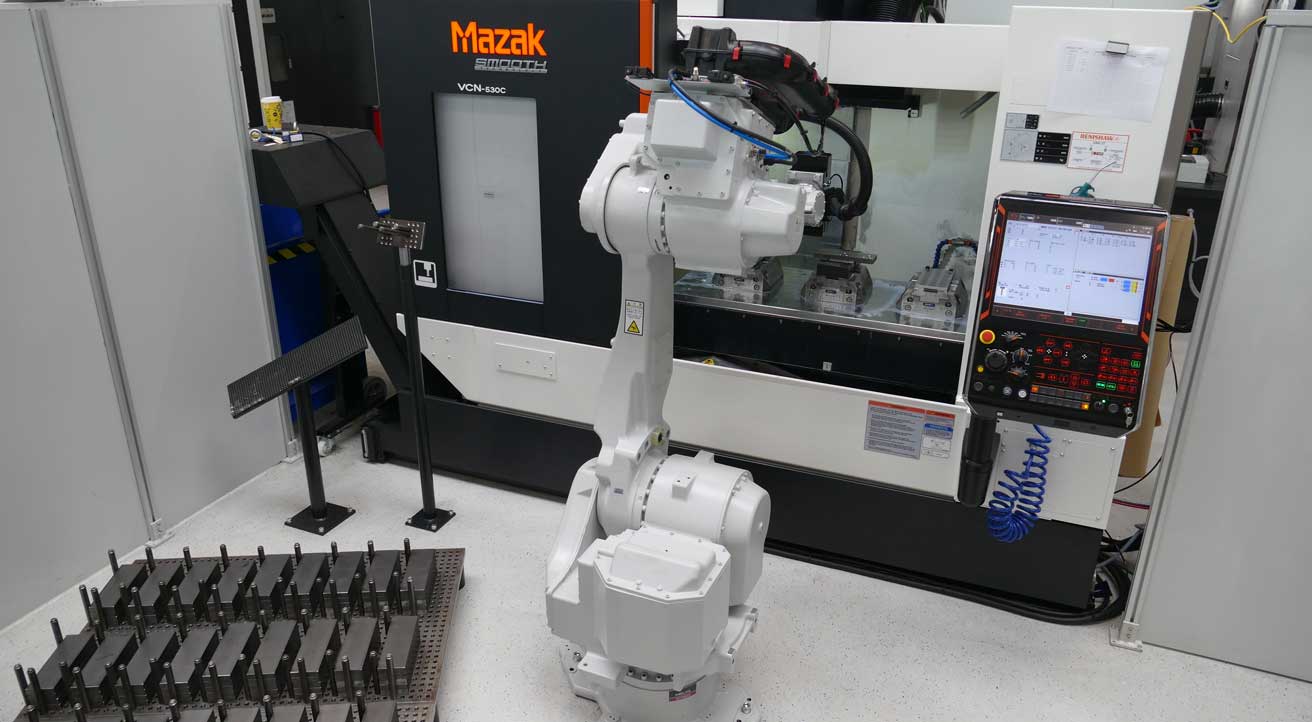
07.02.2020 | There are still mechanical engineering companies that manufacture the components they need exclusively in Germany and are also profitable at the same time. the Durwen mechanical engineering GmbH manages this because it has implemented a high degree of automation in its production. In making his Attachments for forklifts For example, the control of the CNC milling machines communicates directly with the handling robots from Mitsubishi Electric and does not need a higher-level master.
The Durwen mechanical engineering GmbH develops, produces and sells attachments for forklift trucks and is successful in this segment worldwide. These attachments can hold up to four Euro pallets next to each other and two in a row. During operation, they can be changed from multiple to single forks and vice versa without manual intervention by the forklift driver.
 Geiger Handling relies on the Gimatic gripper portfolio
Geiger Handling relies on the Gimatic gripper portfolio
You grab paper rolls weighing tons for example for the printing industry. They rotate the loads they have picked up by up to 360°. Last but not least, they can be specially designed for specific applications. In this market niche for flexible add-on parts for forklifts, Durwen has made a name for itself around the world in recent years.
“Our attachments consist of various standard and special modules. We manufacture them in a wide variety 3-axis CNC machines from the Japanese manufacturer Mazak. Our production takes place 100 percent here at the Plaidt location. This gives us maximum vertical integration, ”explains Managing Director Klaus Durwen.
Automation by industrial robots
 By 2015, employees had to manually insert the blanks for the required parts into the CNC milling machines. The respective machining program then ran between two and ten minutes depending on the complexity of the component. This employee then takes the finished part out of the system, inserted a new blank and the cycle started again. The procedure was repeated from individual parts to several hundred pieces in series production.
By 2015, employees had to manually insert the blanks for the required parts into the CNC milling machines. The respective machining program then ran between two and ten minutes depending on the complexity of the component. This employee then takes the finished part out of the system, inserted a new blank and the cycle started again. The procedure was repeated from individual parts to several hundred pieces in series production.
"This approach was ineffective and uneconomical, so we automated this production step, ”recalls Christian Fuchshofen, production manager at Durwen.
The basic idea was developed, the motion sequences when inserting and removing the parts in and out of the CNC milling centers Industrial robots to be carried out - always the same. Christian Fuchshofen and his team decided on a 6-axis industrial robot from Mitsubishi Electric after intensive research and feasibility studies.
And for good reason: “Mazak's CNC milling centers work on the basis of control technology from Mitsubishi Electric. We were therefore able to do a direct one very easily Communication between the CNC and the robot controller via CC-Link, without a superordinate one that is otherwise common in such constellations Master control in the plant, ”explains the production manager
Handling robot without a master
 The open one Network CC-Link provides protocols for data transmission. That made the handling robot from Mitsubishi Electric is so attractive for Durwen. “We already had many years of experience with the controls of the CNC milling machines. In addition to the pure hardware savings due to the elimination of one master per cell, we were also able to start programming the communication between the articulated arm robot and the CNC milling machine without a long training period," says Mr. Fuchshofen.
The open one Network CC-Link provides protocols for data transmission. That made the handling robot from Mitsubishi Electric is so attractive for Durwen. “We already had many years of experience with the controls of the CNC milling machines. In addition to the pure hardware savings due to the elimination of one master per cell, we were also able to start programming the communication between the articulated arm robot and the CNC milling machine without a long training period," says Mr. Fuchshofen.
The developers integrated the GT25 operator panel from Mitsubishi Electric into the overall system. "This makes it very easy to operate the application when changing over, because the operator does not have to program the articulated-arm robot, but only has to call up the next article," says Chrisitan Fuchshofen.
Articulated arm robot for CNC milling cells
Mitsubishi Electric supported the programming and integration of the first automated CNC milling cell with one RV-13FLM-D1-S15 robot. It went into operation just a few months after delivery. "Due to its payload of up to 13 kg, the reach of 1388 and because it is so precise, this model has proven itself so well that we soon expanded two more milling centers with articulated arm robots of this class," says the production manager .
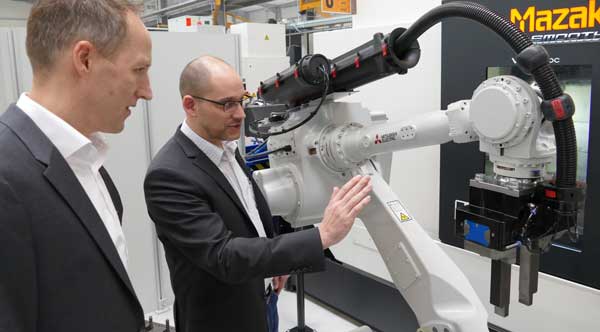 After positive experiences with the first three small robots, the company invested in a brand new articulated arm robot of the type RV-70FLM-D1-S15 just one year later. With 2050 mm range radius and 70 kg payload its six axes are also driven by AC servo motors.
After positive experiences with the first three small robots, the company invested in a brand new articulated arm robot of the type RV-70FLM-D1-S15 just one year later. With 2050 mm range radius and 70 kg payload its six axes are also driven by AC servo motors.
“This decision was a special one for us too,” reports Volker Betke from Mitsubishi Electric, who is responsible for Durwen's sales. “Durwen was the first user in Germany to use a robot from the new 70 kg class. The machine manufacturer was thus a pioneer for this extended generation of robots and a pioneer for the combination of robots and CNC machining centers based on our control technology, ”says Mr. Betke.
The expansion of automation solutions has proven to be a good decision for the Rhinelanders: robots are now loading and unloading a dozen of the 30 or so Durwen milling cells. But that's not all.
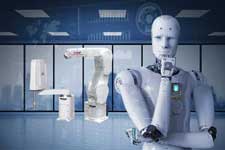 Predictive maintenance with artificial intelligence for robots
Predictive maintenance with artificial intelligence for robots
In addition to selling complete attachments, a fast spare parts service is also important. “Due to the large variety of products and the associated necessary individual components, we cannot always have all parts in stock. "Two of our milling cells are therefore reserved for producing these spare parts," says the production manager. The milling programs for the large number of standard modules can be converted to the currently required components just as quickly as the processes for the robots and the coordination between the two systems thanks to the GT25. Here it pays off that the Control Technology from a single source.
High degree of automation for the future
 One reason for the desired further automation is, according to the company boss, the lack of skilled workers in the region: “We have benefited from these investments in robotics and automation Enables growth, which would not have been possible due to the increase in staff. It is also not easy in our region to find technically interested new employees. Despite the higher level of automation, we did not need to lay off our colleagues. Rather, we helped our staff to obtain better qualifications through further training, ”emphasizes Managing Director Klaus Durwen.
One reason for the desired further automation is, according to the company boss, the lack of skilled workers in the region: “We have benefited from these investments in robotics and automation Enables growth, which would not have been possible due to the increase in staff. It is also not easy in our region to find technically interested new employees. Despite the higher level of automation, we did not need to lay off our colleagues. Rather, we helped our staff to obtain better qualifications through further training, ”emphasizes Managing Director Klaus Durwen.
So there is a lot of basic know-how within the company about Programming of the CNC milling cells and robots were created, from which the company also benefited considerably. An end to the company's growth is currently not in sight. And so Durwen is already planning a substantial expansion of the production hall, which was only built in 2018.
Archive for articulated robot news
Articulated robot with Atex certification impresses inspectors
 10.05.2019/XNUMX/XNUMX | "Melfa" articulated robot from Mitsubishi Electric are used for a wide range of handling tasks. They are also suitable for Explosive areas. That is why the articulated-arm robots are now available with the corresponding individual certification. Because no technical modifications are required for the proof of conformity, the articulated robots can also be delivered without major delays.
10.05.2019/XNUMX/XNUMX | "Melfa" articulated robot from Mitsubishi Electric are used for a wide range of handling tasks. They are also suitable for Explosive areas. That is why the articulated-arm robots are now available with the corresponding individual certification. Because no technical modifications are required for the proof of conformity, the articulated robots can also be delivered without major delays.
Approval of technical devices for potentially explosive atmospheres in accordance with the European Union directive 2014/34 / EU (Atex product directive) requires the individual acceptance of each product for the specific application environment.
In response to customer demand, Mitsubishi Electric recently had two 6-axis articulated robot of the RV series with a maximum load capacity of 7 kg and protection class IP67 as standard by the explosion protection specialist AEP Zimmer from Mannheim: The RV-7FRM-D Ex3G robot achieves explosion protection class II 3G c IIB T3 Gc.
"The testers were very impressed because no modifications at all were necessary on the series devices," says Michael Finke, Product Manager Robots at Mitsubishi Electric. "Only the operating instructions had to be expanded to include a chapter that contains special information on the use of industrial robots in potentially explosive areas."
Because the articulated robots their Ex-suitability ex works bring along - including the possibility of creating a negative or positive pressure in the housing - they can be delivered at short notice with Atex certification.
“The current devices were designed for 2 Zone (gases, vapours) certified,” says Michael Finke. Typical areas of application for Atex robots are paint shops and handling tasks in areas where explosive atmospheres can occur.
Robot finds parts and boxes based on 3D images
 02.11.2017 | Exhibited at Motek 2017 Isy's vision the completely revised version of his application Mikado ARC - Adaptive Robot Control before. The 3D vision system on a Mitsubishi Electric RV-4FLM articulated robot communicates in real time with the associated robot controller. The system is designed for continuous operation and can be adapted extremely quickly to new workflows thanks to the software.
02.11.2017 | Exhibited at Motek 2017 Isy's vision the completely revised version of his application Mikado ARC - Adaptive Robot Control before. The 3D vision system on a Mitsubishi Electric RV-4FLM articulated robot communicates in real time with the associated robot controller. The system is designed for continuous operation and can be adapted extremely quickly to new workflows thanks to the software.
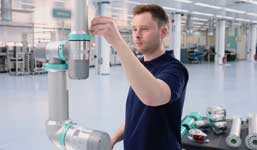 Safety brake protects Robco robot kit
Safety brake protects Robco robot kit
The Reach into the parts box (Bin-picking) is ubiquitous in industrial assembly but notoriously difficult to automate. With a Mikado ARC control, gripping positions are no longer permanently taught or programmed, but the articulated robot finds the parts independently based on the 3D image. The sequence of movements for grabbing, driving and putting down is checked for collisions. Within the workspace, Mikado ARC can also find the supplied crates. The gripped parts are transferred to subsequent machines in the correct position or placed in blister packs, magazines or other receptacles.
Sensitivity of the gripping and movement process customizable
 The sensitivity of the gripping and movement process in Mikado ARC can be adjusted: it pushes aside robust semi-finished products if necessary, and grips sensitive products without colliding. the 3D-Image Processing by Mikado ARC can also difficult, i. H. detect particularly dark or shiny metallic parts and is largely insensitive to extraneous light.
The sensitivity of the gripping and movement process in Mikado ARC can be adjusted: it pushes aside robust semi-finished products if necessary, and grips sensitive products without colliding. the 3D-Image Processing by Mikado ARC can also difficult, i. H. detect particularly dark or shiny metallic parts and is largely insensitive to extraneous light.
Mikado ARC provides straightforward tools for defining the robot cell. Workpieces are simply defined by taking over the existing CAD data. The path calculation and the finding and depositing of the parts then take place autonomously and unattended.
No special knowledge is required to set up the robot: where a programmer used to spend two days changing products, the production manager can now, for example, drag and drop parameterize what he considers the best picking solution for the process. Furthermore, the new system version enables simulation for risk-free error checking and optimization before commissioning. Adapting to the new workflow only takes ten minutes – visitors to the stand were able to see this for themselves.
 Fruitcore Robotics extends service to include industrial robot Horst
Fruitcore Robotics extends service to include industrial robot Horst
Although designed as a universal system, Mikado ARC was designed for the Melfa robot developed "because Mitsubishi Electric supports its partners in an exemplary manner. What we can present here after only three years is an enormous success,” says Rene Purwin, Project Manager at Isys Vision. For Mitsubishi Electric, the image processing specialist has been a competent partner for many years, and the company draws on their specialist knowledge. "In this way, we help our customers to optimize their production without unnecessary development effort," says Wolfram Zielke, Key Account Manager at Mitsubishi Electric.
Flow stacker with articulated arm robot for sensitive components
 01.06.2017/XNUMX/XNUMX | Mitsubishi Electric presented a tasty surprise at the Hanover Fair: Am GOT2000 operator terminal of the throughfeed stacker DS-800 from LTL Maschinenbau with compact robot cell RV-2FB-D1-S15 from Mitsubishi Electric, the visitor could select a chocolate coin in the tray and have it issued by the robot.
01.06.2017/XNUMX/XNUMX | Mitsubishi Electric presented a tasty surprise at the Hanover Fair: Am GOT2000 operator terminal of the throughfeed stacker DS-800 from LTL Maschinenbau with compact robot cell RV-2FB-D1-S15 from Mitsubishi Electric, the visitor could select a chocolate coin in the tray and have it issued by the robot.
Automated stackers like that LTL mechanical engineering GmbH, a provider of cross-industry solutions for workpiece handling, play a key role as buffers and assembly aids in production. The supply and storage system filled with chocolate for items in reusable goods carriers (trays) is a type DS-800 flow stacker, which was specially developed for surface or contour-sensitive components such as in plastic injection molding and can achieve container change times of less than 5 s. Depending on the customer's choice, the parts are handled by a Cartesian 3-axis system or an industrial robot.
 Graphic HMI operator terminals for industrial automation
Graphic HMI operator terminals for industrial automation
In the application shown, a vertical Melfa RV-2FB-D1-S15 articulated arm robot is used. “The highlight of the Mitsubishi Electric robot is its mounting on the cell ceiling. This enables us to design the handling processes in an optimal and compact manner,” says a delighted Frank Dollner, CEO of LTL. The agile and 19 kg light robots are predestined for work in the tightest of spaces such as assembly, loading, palletizing and sorting. Their high positioning repeatability of ±0,02 mm makes them interesting even for joining tasks.
 The long service life of the robotic solution requires a corresponding machine design. Here LTL offers a solid steel construction and cell windows made of safety glass. The handling specialist generally recommends equipping with a Melfa robot and gives several reasons for this: "The Mitsubishi Electric Robot has a particularly good price-performance ratio and offers all Melsec control with the GOT2000 touch panel as an integration kit for OEM customers, a one-stop solution. But above all, the colleagues from Mitsubishi Electric provide excellent support.”
The long service life of the robotic solution requires a corresponding machine design. Here LTL offers a solid steel construction and cell windows made of safety glass. The handling specialist generally recommends equipping with a Melfa robot and gives several reasons for this: "The Mitsubishi Electric Robot has a particularly good price-performance ratio and offers all Melsec control with the GOT2000 touch panel as an integration kit for OEM customers, a one-stop solution. But above all, the colleagues from Mitsubishi Electric provide excellent support.”
General technical knowledge
CC-Link stands for Control and Communications Link and was incorporated by Mitsubishi Electric in 1996 as a proprietary company fieldbus Network developed to connect their own automation products. In 1999, Mitsubishi Electric launched CC-Link as an open network due to increasing demand. The data transmission protocols are available to all users who want to develop their own interfaces.
You might also be interested in...

Artificial Intelligence | trends and developments

Mitsubishi Electric | Automating the World

Intelligent CNC control for machine tools

battery production | Facts and Technologies

Industrial Ethernet | Profinet, Powerlink & Co.
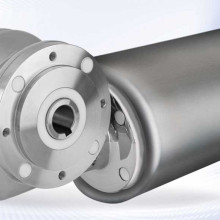
servo motor | Electric motor with control electronics

Thorsten Sienk is a freelance specialist editor in Bodenwerder.
